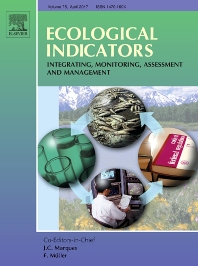Ecological Indicators Q1 Unclaimed
The ultimate aim of Ecological Indicators is to integrate the monitoring and assessment of ecological and environmental indicators with management practices. The journal provides a forum for the discussion of the applied scientific development and review of traditional indicator applications as well as for theoretical, modelling and quantitative approaches such as index development. The journal seeks innovative papers which provide new developmental and methodological steps for environmental indication. It has an SJR impact factor of 1,959.
Ecological Indicators focuses its scope in these topics and keywords: change, indicator, indicators, large, response, based, central, climate, ecosystem, effects, ...
Type: Journal
Type of Copyright:
Languages: English
Open Access Policy: Open Choice
Type of publications:
Publication frecuency: -


3065 €
Inmediate OANPD
Embargoed OA0 €
Non OAMetrics
1,959
SJR Impact factor204
H Index1660
Total Docs (Last Year)4296
Total Docs (3 years)115947
Total Refs37786
Total Cites (3 years)4285
Citable Docs (3 years)8.53
Cites/Doc (2 years)69.85
Ref/DocOther journals with similar parameters
Nature Sustainability Q1
Fungal Diversity Q1
Genome Biology Q1
Human Reproduction Update Q1
Annual Review of Ecology, Evolution, and Systematics Q1
Compare this journals
Aims and Scope
Best articles by citations
Testing different (e)DNA metabarcoding approaches to assess aquatic oligochaete diversity and the biological quality of sediments
View moreAssemblages of breeding birds as indicators of grassland condition
View moreAssessing urban environmental segregation (UES). The case of Santiago de Chile
View moreAn expert system to estimate the pesticide contamination of small streams using benthic macroinvertebrates as bioindicators
View moreSpatial distribution of environmental stress indicators in Concord grape vineyards
View moreMeasuring environmental performance in Asia
View moreExploring management objectives and ecosystem service trade-offs in a semi-arid rangeland basin in southeast Iran
View moreDeriving sustainability measures using statistical data: A case study from the Eisenwurzen, Austria
View moreExploring temporal dynamics of urban ecosystem services in Latin America: The case of Bogota (Colombia) and Santiago (Chile)
View moreA comparative study of the accuracy and effectiveness of Line and Point Intercept Transect methods for coral reef monitoring in the southwestern Indian Ocean islands
View moreStudy of integrated risk regionalisation method for soil contamination in industrial and mining area
View moreSize-frequency patterns in morphometric characteristics of the seagrass Thalassia testudinum reflect environmental variability
View moreSpatiotemporal differences in forest ecological security warning values in Beijing: Using an integrated evaluation index system and system dynamics model
View moreApplication of association analysis for identifing indicator taxa of vulnerable marine ecosystems in the Emperor Seamounts area, North Pacific Ocean
View moreWhat drives the vegetation restoration in Yangtze River basin, China: Climate change or anthropogenic factors?
View moreAssessment of the subtidal macrobenthic community functioning of a temperate estuary following environmental restoration
View moreSmall mammals: consequences of stochastic data variation for modeling indicators of habitat suitability for a well-studied resource
View moreFish-trematode systems as indicators of anthropogenic disturbance: Effects of urbanization on a small stream
View moreA quantitative method to assess the ecological indicator system's effectiveness: a case study of the Ecological Province Construction Indicators of China
View moreA meta-assessment for elasmobranchs based on dietary data and Bayesian networks
View moreScale dependence of landscape metrics and their indicatory value for nutrient and organic matter losses from catchments
View moreCellular toxicity mechanisms of lambda-cyhalothrin in Venus verrucosa as revealed by fatty acid composition, redox status and histopathological changes
View moreA methodological approach to assess and compare the sustainability level of agricultural plant production systems
View moreLeaf non-structural carbohydrates regulated by plant functional groups and climate: Evidences from a tropical to cold-temperate forest transect
View more
Comments